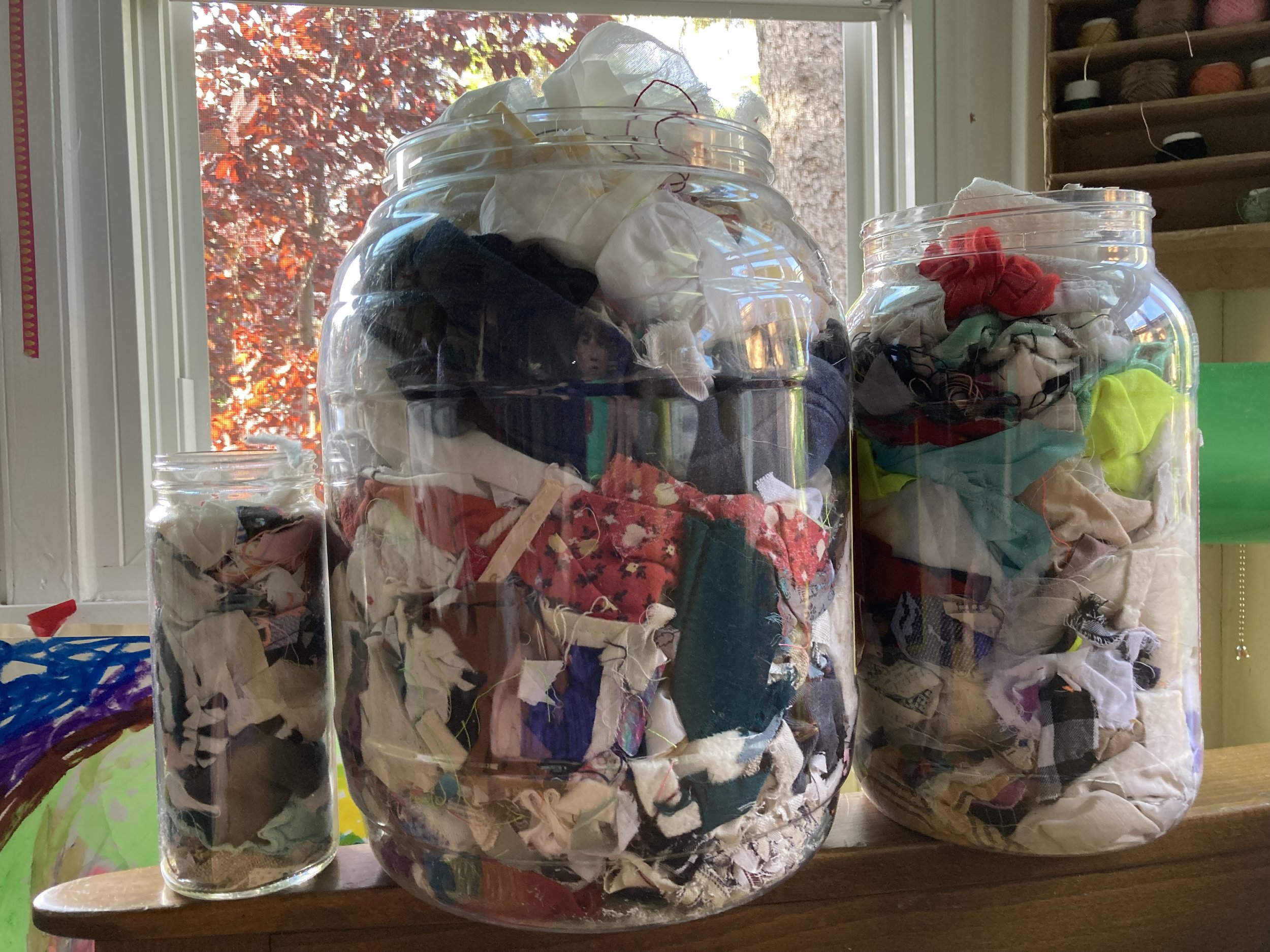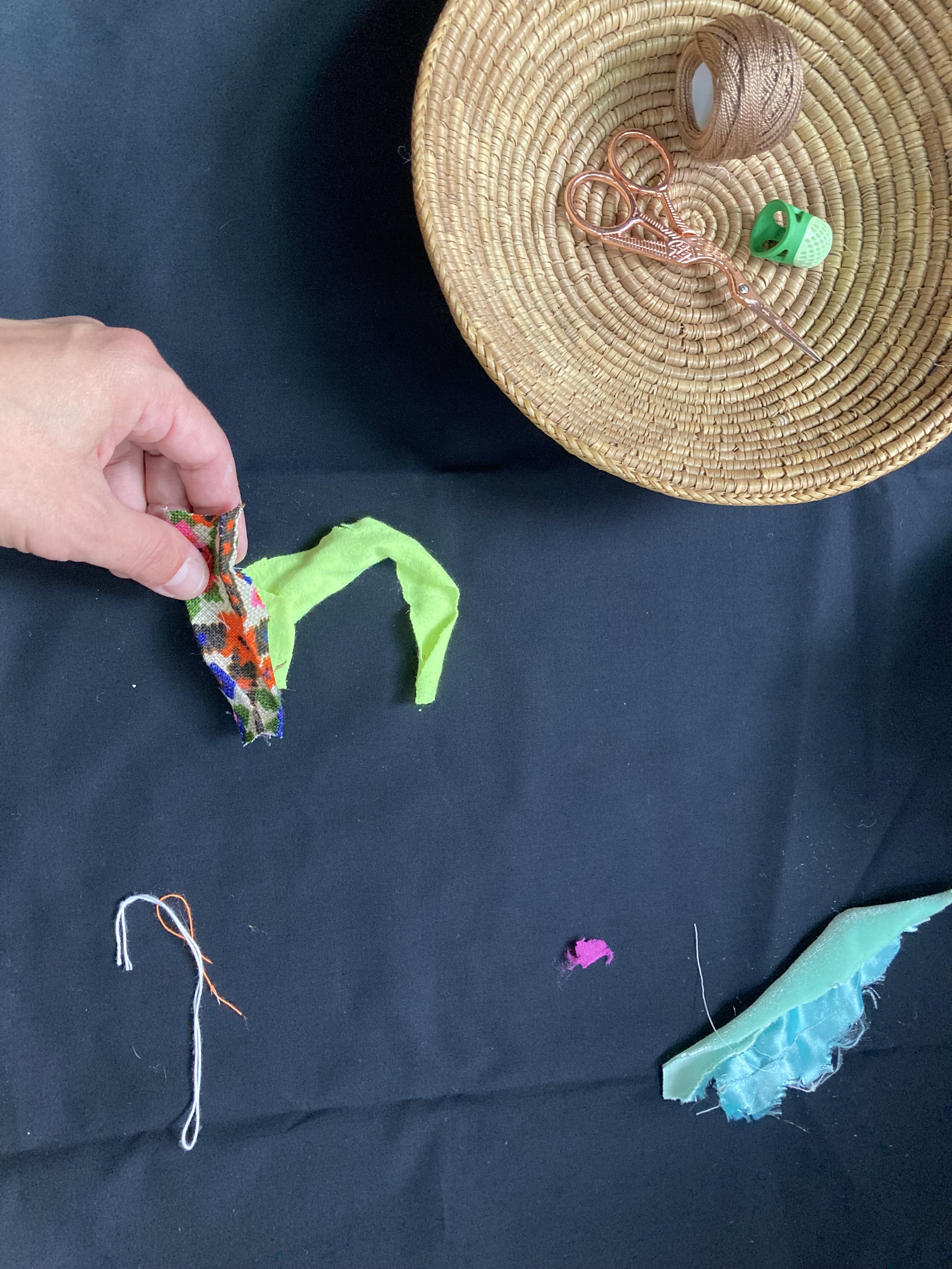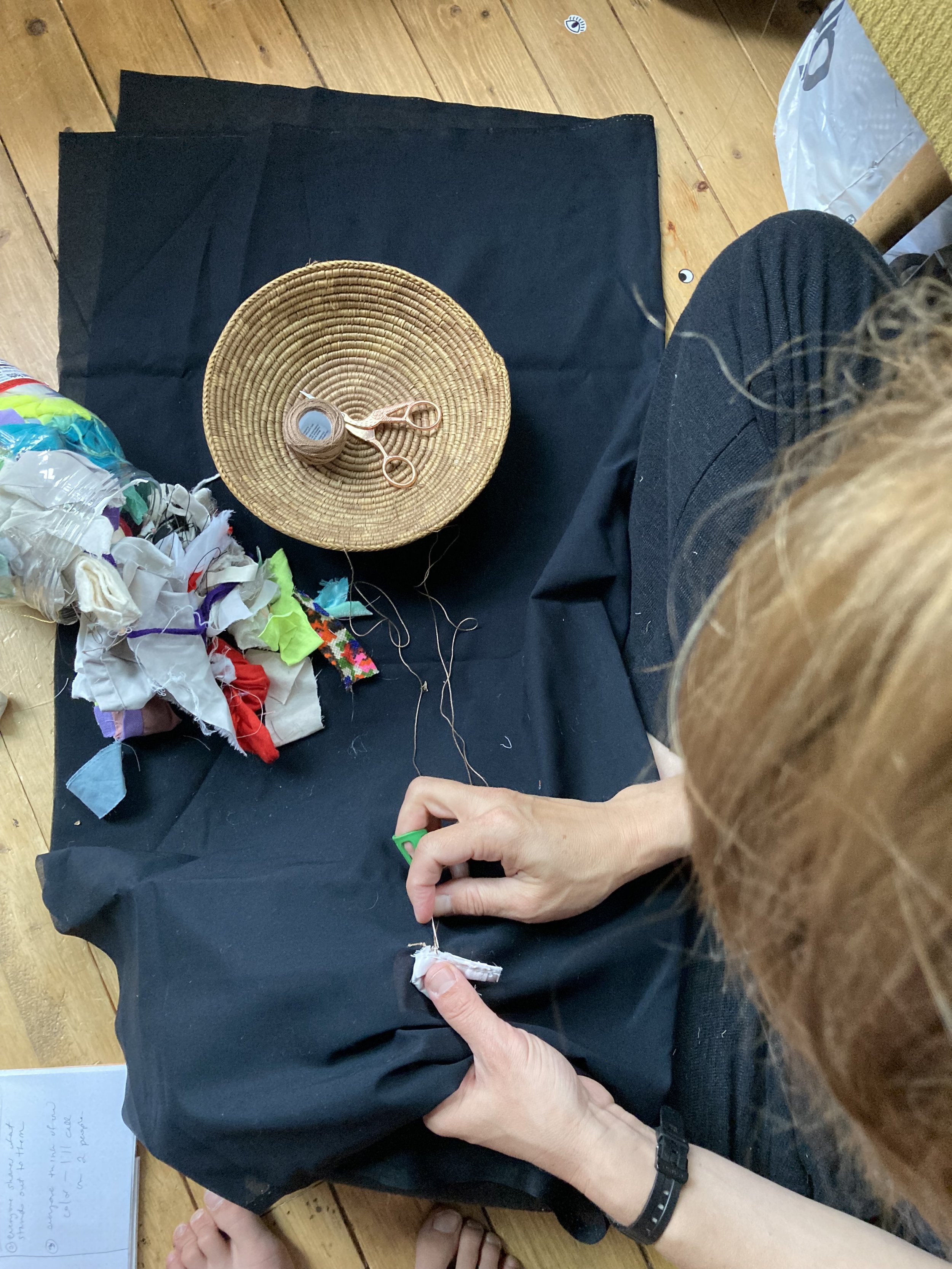A Calm space
Amanda Nadig
“I used to ask my parents, ‘Are there aliens out there?’”
Interview by L. Valena
Let’s talk about your piece. First, could you start by describing what you responded to?
Okay. I got what looked like a digital work, a portrait. I saw a lot of blues. I remember there being a lot of wavy lines, kind of echoing around the figure's face, and the mouth was open. In my artistic practice, I usually have my kids involved in some way because my studio is in my home and they’re just always there. So I asked them what they saw. They said they saw stress, which I see. And they said water. I was like, Oh yeah, I do see the figure coming out of the water, maybe.
That’s so cool! Did you just show it to them and have a conversation? Or did they do drawings or something? Tell me about that.
They were busy, you know, doing what little boys do. I have a five- and a ten-year-old. I just pulled this artwork up on my phone and said, Hey, come on over. We just talked about it a little bit. I asked them, What makes you say that? What do you see? What about it the image makes you say that? First I spent some time alone with it, just looking at it on my phone. Then they looked at it. Then I let a little bit of time pass before I looked at it again. I saw the figure differently after my kids and I talked about, which was cool. And I did look at it on a larger computer screen before I worked on my piece.
What happened next?
I’m a quilter. I work with just thrifted fabrics. I don’t like to buy anything; it’s important for me to just use up fabrics I already have.
When I feel stressed, I try to model for my kids the ways in which I cope with that anxiety. So I wanted to make a piece that felt the opposite of stressed. And I wanted to create my piece using textiles because I am a quilter. When you quilt a piece, it’s a bunch of repeating lines holding three layers together. I was thinking about quilting with straight lines, because horizontal lines make me feel calmer than diagonal or curved lines. Then I focused on the inside of the mouth because that felt like the focal point for me. It was like a galaxy. I remember being really drawn to that inside of the mouth. It felt like it was like a portal and entry point to something in there. So I started with black because that’s what I think of when I think of space. I’ve been exploring using up my tiny, tiny scraps, so I threw those down on the black fabric and thought they looked like little galaxies. This is how I began.
It’s so cool. I’m a textile person and I always save little scraps, but the tiny tiny ones? I’m like, Well, this is no good for anything. I think, Maybe I can use this to stuff something else or there’s some possibility, but I never think to save those tiny little pieces.
And where are you gonna put them? Yeah, some do end up thrown out, but not most. I save jars, like mason jars. And I’m a little ashamed to say we have a lot of those huge empty cheese ball plastic jars, and they fit my fabric scraps perfectly. They are clear so you can see the scraps you have and I’m more likely to use them this way.
That’s awesome!
Plus, I have a really small home studio and my kids are in and out. I love that whether I plan on it or not, they become a part of my process. So they will come in and dig in them and create little imagined characters or whatever. And when the fabric scraps end up spread all over the place, I just jam them back in the jars.
You said that the focal point for you was this idea of kind of galaxies and space. Is that something that you think about much? Do you usually work with those concepts in your art?
No, not really. First of all, the idea of a huge universe is a little frightening to me. As a kid, Unsolved Mysteries was on TV all the time and I was so frightened by the idea of life on other planets. Like this one episode where an alien came into this girl’s room while she was sleeping. I used to ask my parents, “Are there aliens out there?” The universe is something that I cannot wrap my head around, like how neverending it feels. So I look in this figure’s mouth and see that there is this place, that we can’t even explain, you know? It’s a little mysterious to me. That and being underwater, the ocean is another thing that is so big and you don’t know how deep it is. Those ideas make me uncomfortable.
The way I quilted this piece, with the tiny white lines on the black fabric which feel like little stars and contrast with the dark background, they bring me to a calmer place. So no, I don’t normally make work about space, but I am really interested in responding to something that really sucks me in, you know?
I think this is such an interesting tension between stress and calm. Your kids said it felt stressful, so you tried to think of a calm place, so you were making this calm place that is outer space, but space is actually kind of scary. It’s really an interesting tension that you’re playing with.
It’s funny that you say tension, because I’m working on a commission right now, like a totally different piece. This client wants a wall quilt for his room. I asked, What are you drawn to in my work? Just so I know what elements to incorporate. He said, I really like the tension in your work. I had never even thought of using that word to describe my work before. But guess I do create tension by juxtaposing different fabrics. I’ll take a shiny fabric and place it next to a fabric that’s maybe sheer. I like to juxtapose shiny versus matte as well as using neutral and neon fabrics together. Even in the outfits I wear, I don’t want the top and bottom to match perfectly. I want there to be a little bit that’s off. I think that’s tension. So I think I wanted to create an opposite emotion from the artwork I responded to.
Is there any aspect of this work or its process that I haven’t asked you about yet?
Yeah, so I didn’t read the title of the artist’s work right away. It is named Surfacing, and I’m glad I didn’t see the title, because then I would have definitely connected it to water. And then this could have gone in a completely different direction. Instead, the first thing my kids and I noticed was how the piece made us feel. My work is more about color, texture in shape and very abstract, so I was a little nervous, because the work I responded to is a really realistic, beautifully drawn portrait. And I don’t work digitally. So I thought it’d be cool to translate something with a realistic subject and a medium I don’t ever work with, into my style and my medium. I wanted to know who this figure and the artist was, and what they were thinking when they made this piece. But that’s part of the fun challenge of this project.
I think that’s the hardest thing, for everyone, really. When you don’t have that context and you have to guess what the artist was thinking, you just have to go with whatever comes up for you, and that’s very vulnerable, you know? You can’t check your references or something, even though you might really have a desire to do something like that, I think, as an artist.
Yeah. It’s also really important to just experience work. We don’t have to know the context. Also, I’ve been making a lot of new work, especially in the last year, and just giving myself permission to just dive in. I think it was helpful that you get a very short amount of time. We’re given only two weeks. That really encourages you to dive in and just make something.
Do you have any other advice for someone else who is approaching this for the first time?
Just work in a medium that you feel like working with that day. Don’t worry about what it’s going to look like. Just whatever feels good to you. At that moment, I was working on a similar style of quilts, and I wanted to explore that more so I used this piece as an excuse to use some more of those little fabric scraps. Pick whatever medium you’re comfortable with.
Call Number: Y55VA | Y57VA.naA
Amanda Nadig is a textile artist who finds inspiration in keeping with and breaking away from traditions in quilting. Each uniquely composed quilt combines colors, shapes, textures and patterns discovered in all types of found fabrics. Amanda has been a high school art teacher in the Chicago Public Schools since 2003.







